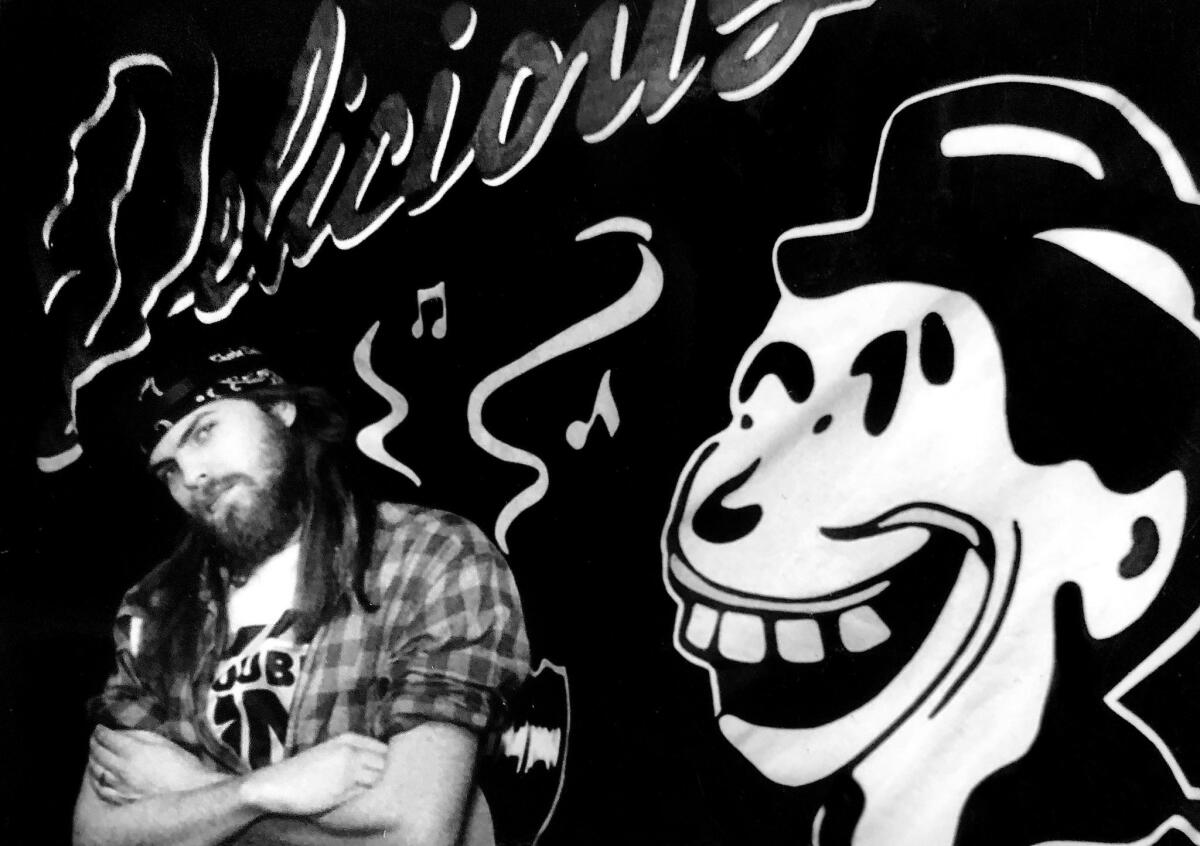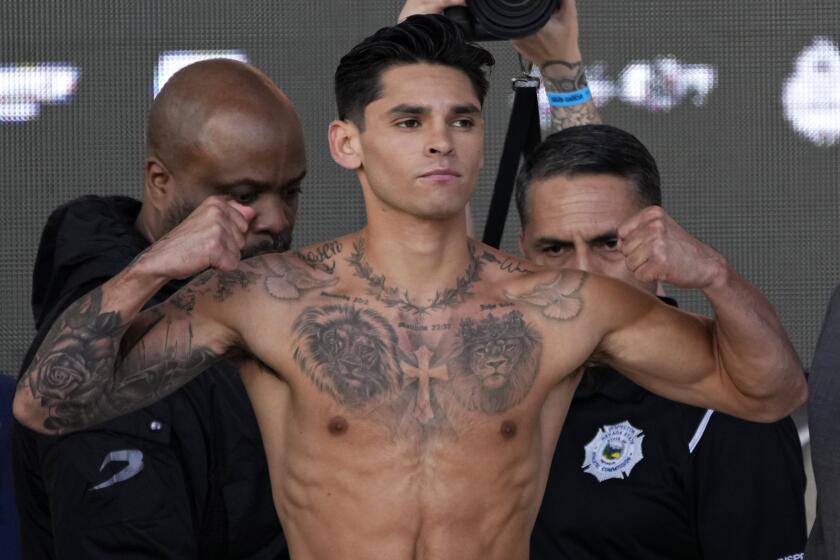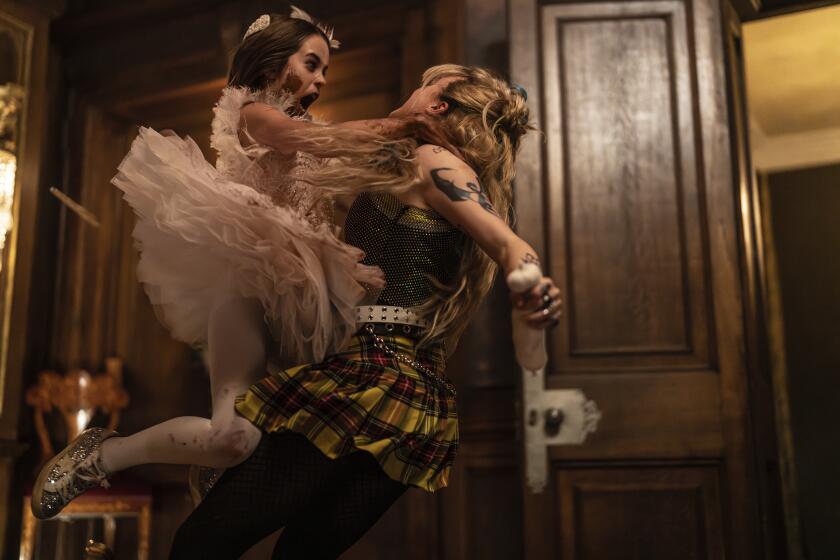Appreciation: Matt Dike, mercurial co-founder of rap label Delicious Vinyl and collaborator on Beastie Boys’ ‘Paul’s Boutique’

Though he was deliberately not a household name, the music that the producer and DJ Matt Dike created, sampled and spun helped define underground Los Angeles in the 1980s.
Dike, whose death was announced on Tuesday via the label he co-founded with Michael Ross, Delicious Vinyl, produced or co-produced some of the biggest rap hits to come out of the West Coast in the late 1980s, including Tone Loc’s “Wild Thing” and Young MC’s “Bust a Move.” Dike was a key figure in the creation of the Beastie Boys’ seminal 1989 album, “Paul’s Boutique,” and helped define the sample-heavy mash-up style that connected rap, punk, arena rock, pop and disco.
Corrección:
7:30 a.m. mar. 14, 2018The original version of this post wrongly identified Matt Dike as the producer of Beach Boy Brian Wilson’s only known rap song. In fact, according to an interview with Dike chronicler Peter Relic, Dike declined Wilson’s invitation to collaborate on a rap song. The text has been updated with this information. In addition, Dike died at age 55 -- not, as relayed by his family in the original post, 56.
Dike’s death, which was confirmed by Dike’s brother Lane, occurred in mid-January and followed a battle with salivary gland cancer. He was 55.
A singular figure, Dike at various points in his life was artist Jean-Michel Basquiat’s roommate, L.A. club-land’s hottest DJ, and a record, cassette and VHS collector who documented the early New York and Los Angeles art, hip-hop and post-disco scenes.
Across a whirlwind decade that began when he moved from New York to Los Angeles in 1980, Dike’s contributions were as diverse as remixing Aerosmith and collaborating with former Public Image Limited guitarist Keith Levene. He co-produced the first-ever track to diss N.W.A (Romeo and Master Rhyme’s “Crackerjack”) and served as a club DJ to Ice-T as the rapper-turned-actor was trying to bust into the scene.
Then, at the peak of his success after earning millions from Delicious Vinyl, Dike bought a mansion atop a hill in Echo Park and retreated completely from public life. For the next quarter-century, he led a nearly hermitic existence, surrounded by his record, tape and art collections, reaching out to friends via text message and telephone, cruising down the hill in his VW Beetle to Trader Joe’s for supplies and returning home.
He remained a virtual recluse until he died, but Dike packed a lot of action into his years on the L.A. scene. While in his early 20s, he co-founded the crucial L.A. club Power Tools, where he deejayed massive gatherings, mixing disco, rock and rap records, injecting his own rhythms into the tracks, in the process becoming a charismatic king of L.A. nightlife.
“He was a guy who really immersed himself in whatever he was interested in,” says writer Dan LeRoy, whose book on “Paul’s Boutique” remains a definitive resource on the album’s creation. LeRoy remembers Dike as a striking conversationalist during his years of solitude, one who could recall in vivid detail his experiences.
I’ve seen him drop ‘God Save the Queen’ by the Sex Pistols into a heated dance floor at midnight and 2,000 people go completely nuts. The guy was uncanny.
— Jon Sidel, co-founder of Power Tools
After Dike moved to L.A., he and a few other promoters helped define the underground English-language club scene in the 1980s, says LeRoy. “They did it, I think, by bringing a lot of what Matt brought with him from New York, which is this attitude that, ‘We’re going to mix everything up.’”
When the late photographer Brad Branson, who had a mid-Wilshire studio in a former power tools shop, suggested a one-off party at his spot, business partner Jon Sidel and Dike said yes, and Power Tools was born. It proved so successful — Andy Warhol showed up — that the trio decided to make it a word-of-mouth weekly. With a capacity of 150, it turned into a weekly sellout.
“Matt was at the center, and Matt was the coolest guy,” recalls Sidel. The two had befriended each other at an early ’80s weekly club called the Rhythm Lounge, held each Thursday at the Grandia Room on Melrose Avenue (near Larchmont). The event counted as its master of ceremonies Ice-T. Sidel describes the party as “the first hip hop club in L.A.”
Power Tools was forced to move after the police shut it down and, after a period of rootlessness, went legit at the Park Plaza Hotel. (For his part, Branson relocated to Europe — through an invite from pop star George Michael.) At its peak in 1986, the event took over the spot on Saturdays and became a hub that connected revelers including David Bowie, Annie Lennox, David Geffen and members of bands including the Red Hot Chili Peppers, Jane’s Addiction and Thelonious Monster.
“He was the first stop on the vibe line when I touched down in L.A. back in the day,” wrote Dante Ross, senior vice president of A&R for Asylum Records, who earned his early reputation at Tommy Boy Records, in an Instagram post. Ross added via email, “He was a brilliant cat. I thought he was the next Rick Rubin.”
“If he could drop ‘Ventura Highway’ by America into a dance set and make it work, he would,” Sidel says of Dike’s skills as a DJ. “I’ve seen him drop ‘God Save the Queen’ by the Sex Pistols into a heated dance floor at midnight and 2,000 people go completely nuts. The guy was uncanny. He was like a DJ savant.” One friend estimated that Dike’s collection contained at least 40,000 albums and 12-inch singles.
Dike was among the first West Coast DJs to spin rising New York rap label Def Jam’s early releases, a relationship forged early on through a night on the town with a visiting Rick Rubin.
It wasn’t just music: “We’d have projections and go-go dancers and bands and theme nights,” Sidel says. They had a party for visual artist Keith Haring and another for the director John Waters, all through resources that Sidel describes as “a $500 budget and duct tape.”
Dike was also an assistant at art dealer Larry Gogosian’s Los Angeles gallery, where Dike forged a friendship with the artist Jean-Michel Basquiat after an early interaction in New York.
Sound engineer and producer Mario Caldato Jr. recalls both the painter and “Yo! MTV Raps” connector Fab Five Freddy crashing at Dike’s place whenever they were in town. Dike ended up with a number of Basquiat paintings through that friendship, works that were spread among the mess of his Echo Park belongings after he retired from music.
“These were well-respected New York cats — artists and poets, guys who had some flavor, and obviously everybody into music,” Caldato says.
Caldato, who went on to become a frequent collaborator and touring member of the Beastie Boys, met Dike and Sidel at Power Tools on the night in 1986 that the Beastie Boys first performed in L.A. He didn’t know the group, but as they were going into their second song, the sound system crashed.
Mike D stopped by, I presumed because of Power Tools, and because everyone seemed to get in touch with Matt to find out what was going down in town.
— John King of the Dust Bros., on an early Beastie Boys encounter
“I’m a sound guy, so I’m in the audience and I”m like, ‘Whoa, that’s lame.’ These guys are onstage throwing mikes around, cursing,” Caldato says.
As a young engineer, Caldato was baffled at how such an enterprise expected to throw parties with home stereo system. He pitched Sidel and Dike and came on as the Power Tools sound guy, and eventually joined Dike on his next adventure.
Dike and friend, production partner and business partner Ross, formed Delicious Vinyl in 1987, and by the late-’80s they’d earned their first national hit through a collaboration with rapper Tone Loc. Called “Wild Thing,” it sold 2 million copies and set the stage for the label’s quick rise. Dike and Ross, along with a young production team consisting of John King and Michael Simpson, who shared a radio show at Claremont College, produced the tracks on the album.
Through those hits, Dike, King and Simpson hooked up with the Beastie Boys, who were trying to figure out how to follow up their smash debut album, “Licensed to Ill.” Accounts differ on the genesis of the “Paul’s Boutique” collaboration.
Caldato Jr. recalls sending a few demos in the mail, the band loving them and heading west.
In an email, the Dust Brothers’ John King cites a moment when he, Dike and fellow Brother Michael Simpson ensnared a visiting Beastie Boy Mike Diamond as the key.
“Mike D stopped by, I presumed because of Power Tools, and because everyone seemed to get in touch with Matt to find out what was going down in town,” King writes. “Matt had a tape of songs Mike Simpson and I (and sometimes Matt) had been working on to be a ‘Dust Brothers Album,’ which he slyly started playing as background music on a ghetto blaster.”
Diamond noticed the music and asked what it was. According to King, they told him “it was just something we were working on, [and] Mike D asked ‘Can I buy this?’” The trio, King adds, “busted our asses to do a little more work and get a worthy instrumental demo tape to the Beastie Boys.”
The Beastie Boys holed up with Dike, Caldato and the Dust Brothers, mostly in Dike’s studio, and came out with “Paul’s Boutique.”
The smooth opening sample on the album, of jazz drummer Idris Muhammad’s “Loran’s Dance,” came from Dike’s collection, and the humming tones suggested a new direction forward.
Matt was like the Howard Hughes of hip hop. Where did he go? This guy invented something that is now a mainstream part of entertainment.
— Bob Forrest, addict advocate and singer for Thelonious Monster
“It was the perfect point of departure for hip-hop at that juncture -- a moment where sampling styles were changing, and the bombast of Public Enemy’s production team the Bomb Squadwas giving way to something more minimal,” said music historian, collector and Madlib’s manager Eothen Alapatt of Now-Again Records. “Matt was part of that mission statement, and for that alone he’ll always be an important member of the hip-hop canon.”
Dike, however, was uninterested in chasing mainstream success. Friends say that while he was never the party animal of the crowd, his alienation with the music business was peaking as he started experimenting with drugs. By 1991, he’d pretty much checked out of the scene.
His friend Bob Forrest, best known as singer for Thelonious Monster and addiction advocate on the series “Celebrity Rehab,” recalled Dike and he becoming so frustrated by the scene that they started spreading a rumor about a better, more exclusive — but nonexistent — club called Frampton’s Loft. Soon hipsters were abuzz and looking for an in.
In this alienation, Dike developed a heroin addiction that would tether him for the rest of his life.
At one point Sidel, who was also experimenting with drugs, confronted Dike about his choices. “I was like, ‘Dude, what are you doing? You’ve got all these hit records and you’ve got this house you don’t even live in’ — he had bought this killer house, he never fixed it up and he was still in his apartment.”
Eventually Dike moved in and stayed. Over the years, Dike’s family and friends repeatedly tried to get Dike into rehab, but, according to Forrest, his desire for isolation fueled his addiction. Forrest notes that even during these efforts, “anything he put his mind on he would have an interesting take on.”
At one point Dike asked Forrest a rhetorical question: “Do you know what’s the worst thing for a drug addict?”
Forrest said he could think of a few, and asked for Dike’s answer.
Replied Dike: “Unlimited resources.”
In fact, more than one of his friends compared Dike’s long goodbye to a more famous recluse, says Forrest. “Matt was like the Howard Hughes of hip hop. Where did he go? This guy invented something that is now a mainstream part of entertainment.”
For tips, records, snapshots and stories on Los Angeles music culture, follow Randall Roberts on Twitter and Instagram: @liledit. Email: randall.roberts@latimes.com.
ALSO
California Sounds: New underground work from If I Die in Mississippi, Sam Gendel and Michael Seyer
Goldenvoice’s Paul Tollett on why the promoter opted to continue FYF Fest
California Sounds: E Ruscha V video premiere, and new songs by Alice Bag, the Marías and Lord Huron
UPDATES:
March 15, 7:35 a.m.: This article has been updated to include new quotes and information from Dike’s friends, family and collaborators.
March 15, 7:57 a.m.: This article has been updated to include new comments from record executive Dante Ross.
March 16, 12:38 p.m. Updated with new information from Delicious Vinyl owner and co-founder Michael Ross.
This article was originally published on March 13 at 5:05 p.m.




